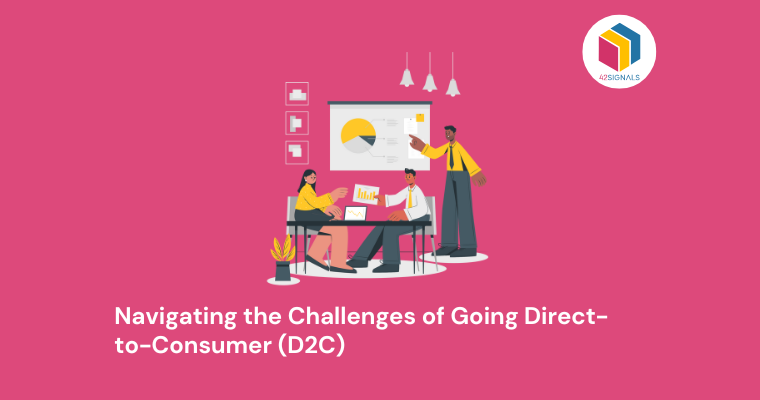Direct-to-consumer (D2C) business models have been gaining popularity in recent years as companies aim to establish a stronger connection with their end consumers and improve overall profitability by eliminating intermediaries. This strategy allows businesses to take control of their branding, pricing, distribution, and customer data while also enabling them to build more personalized relationships directly with their target audience.
As a result, many brands have experienced increased revenue growth, higher customer loyalty, and better insights into consumer behavior through adopting D2C approaches. While there are a few D2C challenges associated with building such a brand, such as –
- Infrastructure requirements: A successful D2C operation requires significant investment in technology infrastructure, including e-commerce platforms, payment systems, logistics management tools, inventory management software, and analytics capabilities. These investments could be substantial for smaller businesses or startups with limited resources.
- Customer acquisition costs: Without established partnerships with existing retailers or distributors, businesses venturing into D2C will need to invest heavily in marketing efforts to attract new customers. The cost per acquisition (CPA) might initially be high due to intense competition online and the need to create awareness about the brand’s shift towards a D2C approach.
- Shipping & fulfillment complexities: Managing shipping, handling, and last-mile delivery efficiently can be challenging when operating at scale. Businesses must consider various factors like packaging, transportation modes, customs regulations, taxes, returns processing, and managing multiple carrier contracts simultaneously. Inefficiencies in these areas can lead to increased operational expenses and negatively affect customer satisfaction levels.
- Scaling issues: While it may be relatively easy to manage small volumes of orders manually during the initial stages, scaling up operations becomes crucial once sales grow significantly. Automation, integration, and process optimization become critical aspects of maintaining efficiency and avoiding bottlenecks in order processing, inventory management, and customer support functions.
- Maintaining consistent brand experience: Providing a seamless and enjoyable shopping experience across all touchpoints – website, mobile app, social media, brick-and-mortar stores – is essential for building long-term customer loyalty. Consistency in messaging, visual identity, tone of voice, and overall quality of interactions play a vital role in shaping how consumers perceive and engage with a brand.
Let’s understand how to address a few of them by adopting the right processes and technology.
Top D2C Challenges Facing Businesses Today
To build a strong direct-to-consumer brand there are a few challenges or hurdles to overcome. With increasing competition and complexities in setting up a business and later marketing it to the right target audience, brands must be prepared and perform the right strategies in various functional areas. Let’s go through a few of these areas –
Building Brand Identity

Image Source: LinkedIn
Firstly, one of the most significant challenges in implementing a D2C strategy is building a strong brand identity. With so many brands vying for consumers’ attention online, creating a unique and memorable brand image is crucial.
Companies must invest time and resources in developing their brand story, values, and visual identity to stand out from competitors. They need to ensure that their messaging resonates with their target audience and consistently communicates their value proposition across all channels.
Data Analytics

Image Source: Catsy
Another challenge lies in mastering data analytics and utilizing technology effectively. A successful D2C model requires collecting and analyzing vast amounts of consumer data to inform marketing strategies, personalize experiences, and optimize sales funnels.
Businesses may struggle to integrate various technologies such as CRM systems, e-commerce platforms, and social media management tools while maintaining robust cybersecurity measures.
To overcome this hurdle, companies should prioritize investing in user-friendly software solutions and training employees on best practices for managing customer data securely.
SEO Optimization

Image Source: RGB Web Tech
Customer acquisition costs (CAC) can also be higher when transitioning to a direct-to-consumer approach due to increased competition and advertising expenses. As more brands adopt paid marketing strategies, paid advertising becomes saturated, leading to rising CPC rates.
Additionally, acquiring new customers through organic means takes longer than leveraging established retail partnerships. Therefore, companies must develop innovative content marketing tactics, SEO optimization, and referral programs to reduce reliance on costly ads and foster long-term growth.
Logistical Optimization
Managing logistics and supply chain operations efficiently presents another set of complexities. When selling directly to consumers, businesses assume responsibility for order fulfillment, shipping, returns, and inventory management – tasks traditionally handled by third-party retailers or distributors. A few D2C challenges faced by brands are in –

Image Source: Medium
- Ensuring timely delivery
- Minimizing damages during transit and
- Providing seamless return processes
require careful planning, investment in reliable infrastructure, and ongoing monitoring. By partnering with trusted carriers and warehousing providers, businesses can alleviate some of these burdens while focusing on core competencies.
Scaling Issues
Lastly, scaling issues are common hurdles faced by businesses as they expand their direct-to-consumer operations. Effective scalability strategies enable organizations to handle increasing demand while maintaining efficient processes, high-quality service, and profitable growth.
This means brands have to get into –
- Process automation
- Supply chain optimization
- Technology infrastructure
- Financial management
- Customer engagement & support
- And, legal and regulatory compliance
Key Takeaways
Despite these D2C challenges, going direct-to-consumer offers numerous benefits, including greater control over pricing, improved customer understanding, and enhanced brand loyalty. Here are three key takeaways to establish a strong D2C brand presence –
- Develop a clear brand narrative: Invest in crafting a compelling brand story that sets you apart from competitors. Ensure consistent messaging across all touchpoints to create top-of-mind awareness and foster emotional connections with your target market.
- Leverage technology wisely: Embrace automation, AI, and machine learning algorithms to streamline operations and deliver personalized customer experiences. Focus on integrating user-friendly software solutions and equipping teams with the necessary skills to manage data responsibly.
- Prioritize relationship building: Nurture long-lasting bonds with your customers by offering exceptional service, responding promptly to feedback, and rewarding loyal advocates. Remember, satisfied clients become powerful ambassadors who fuel word-of-mouth promotion, driving down acquisition costs and boosting overall revenue.
Navigating D2C challenges of going direct-to-consumer might seem overwhelming initially, but strategic planning, adaptability, and commitment to delivering outstanding value make it possible for businesses to thrive in this dynamic landscape.
For brands gearing up to these challenges, 42Signals provides comprehensive market and competitor insights that can be an added advantage.
To know more, schedule a demo today.




